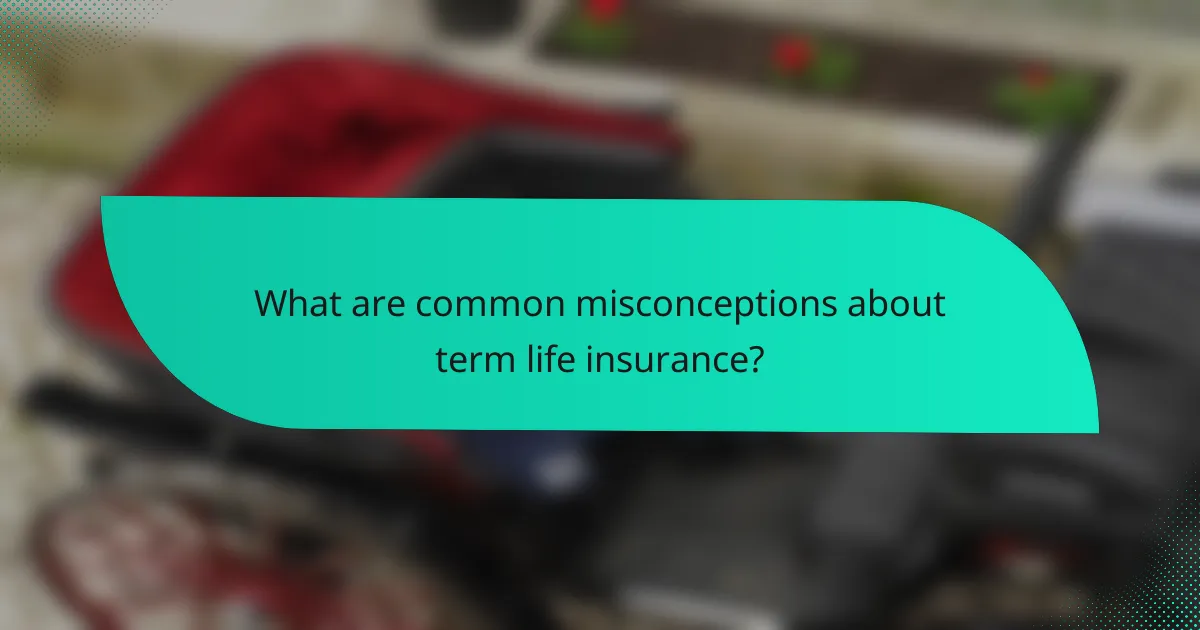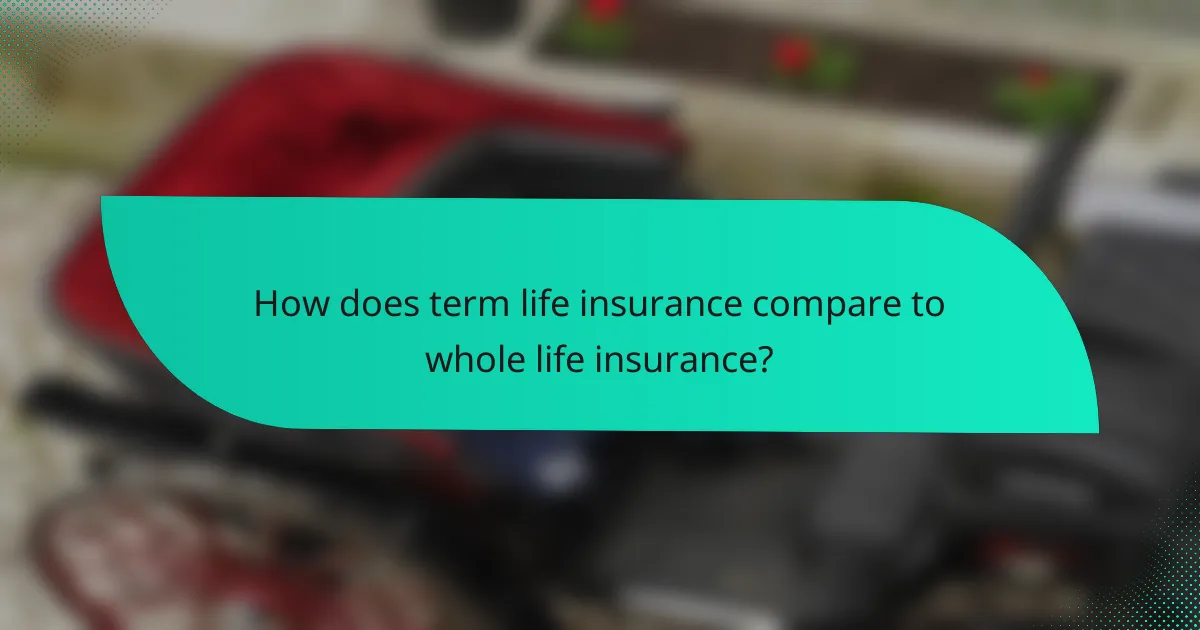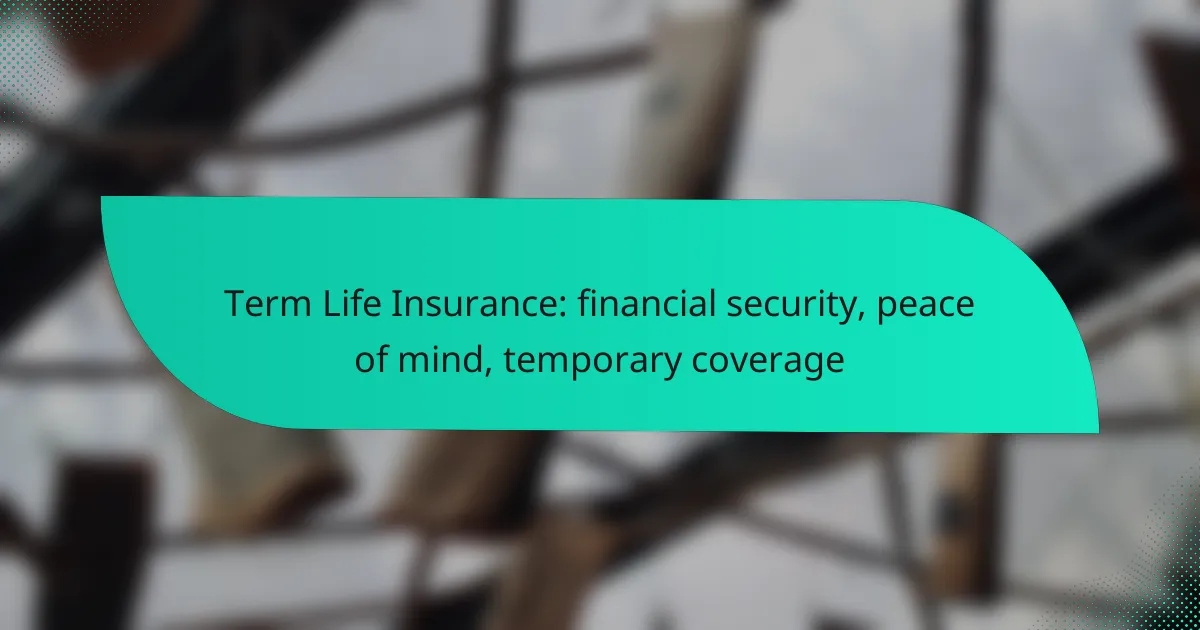Term life insurance provides essential financial security by offering a death benefit to beneficiaries if the insured passes away during the policy term. This temporary coverage is a cost-effective way to protect your loved ones during critical life stages, ensuring they can maintain their standard of living and meet financial obligations.

How does term life insurance provide financial security?
Term life insurance offers financial security by providing a death benefit to beneficiaries if the insured passes away during the policy term. This coverage ensures that loved ones are financially protected during critical years, allowing them to maintain their standard of living and meet financial obligations.
Coverage for dependents
Term life insurance is particularly valuable for individuals with dependents, such as children or spouses. If the policyholder dies unexpectedly, the death benefit can cover living expenses, education costs, and other essential needs for dependents. This ensures that families can continue to thrive without the financial burden of losing a primary income source.
Debt protection
Another key aspect of term life insurance is its role in debt protection. In the event of the policyholder’s death, the death benefit can be used to pay off outstanding debts, such as a mortgage or personal loans. This prevents loved ones from inheriting financial liabilities that could jeopardize their financial stability.
Income replacement
Term life insurance effectively serves as income replacement for families. If the insured individual is the main breadwinner, their death could lead to a significant loss of income. The policy’s death benefit can help replace that income for a specified term, allowing the family to cover daily expenses and maintain their lifestyle during a challenging time.

What are the benefits of term life insurance?
Term life insurance offers financial security and peace of mind by providing temporary coverage at a lower cost compared to permanent policies. It is designed to protect your loved ones during critical periods, such as raising children or paying off a mortgage.
Affordability
One of the primary benefits of term life insurance is its affordability. Premiums are generally lower than those of whole life insurance, making it accessible for many individuals and families. For example, a healthy 30-year-old might pay around $20 to $30 per month for a policy with a coverage amount of $500,000.
This cost-effectiveness allows policyholders to secure substantial coverage without straining their budgets, ensuring that financial protection is within reach.
Flexibility in coverage duration
Term life insurance provides flexibility in coverage duration, allowing you to choose terms that align with your financial responsibilities. Common term lengths include 10, 20, or 30 years, enabling you to match the policy duration with specific life stages, such as child-rearing or mortgage repayment.
This adaptability means you can select a term that fits your needs, ensuring that your loved ones are protected during critical periods without paying for unnecessary coverage afterward.
Simple application process
The application process for term life insurance is typically straightforward and quick. Many insurers offer online applications that can be completed in a matter of minutes, often requiring basic personal information and health history.
Additionally, some policies may not require a medical exam, allowing for faster approval. This simplicity makes it easier for individuals to secure coverage when they need it most, without lengthy delays or complicated procedures.

How to choose the right term life insurance policy?
Choosing the right term life insurance policy involves evaluating your financial needs, comparing different providers, and understanding the specifics of each policy. Focus on your coverage requirements and the terms that best suit your situation to ensure adequate financial security and peace of mind.
Assessing coverage needs
Start by determining how much coverage you need based on your financial obligations, such as mortgage payments, education costs for children, and daily living expenses. A common rule of thumb is to aim for coverage that is 10 to 15 times your annual income.
Consider your current debts and future financial goals. For instance, if you have young children, you might want to ensure they are financially secure until they reach adulthood. This could mean opting for a longer term or higher coverage amount.
Comparing providers like State Farm and Prudential
When comparing life insurance providers, look at their financial stability, customer service ratings, and policy options. State Farm and Prudential are both reputable companies, but they may offer different benefits and pricing structures.
Request quotes from multiple providers to compare premiums and coverage options. Pay attention to any additional features, such as the ability to convert to permanent insurance or riders for critical illness, which can add value to your policy.
Understanding policy terms
Familiarize yourself with key terms in your term life insurance policy, such as the length of the term, premium amounts, and any exclusions. Most policies offer terms ranging from 10 to 30 years, so choose one that aligns with your financial planning.
Be aware of the renewal process and what happens when the term ends. Some policies allow you to renew without a medical exam, but premiums may increase significantly. Understanding these terms will help you make informed decisions about your coverage.

What factors affect term life insurance rates?
Term life insurance rates are influenced by several key factors, including age, health status, occupation, lifestyle choices, coverage amount, and term length. Understanding these elements can help you anticipate costs and make informed decisions when selecting a policy.
Age and health status
Your age and health status are primary determinants of term life insurance rates. Generally, younger applicants with better health receive lower premiums, as they are considered lower risk. For example, a 30-year-old in excellent health may pay significantly less than a 50-year-old with health issues.
Insurance companies often require medical exams or health questionnaires to assess your health. Pre-existing conditions, such as diabetes or heart disease, can lead to higher rates or even denial of coverage. Maintaining a healthy lifestyle can improve your insurability and lower costs.
Occupation and lifestyle choices
Your occupation and lifestyle choices also play a crucial role in determining your term life insurance rates. High-risk jobs, such as those in construction or aviation, typically result in higher premiums due to the increased likelihood of accidents. Conversely, office jobs generally attract lower rates.
Additionally, lifestyle choices like smoking, excessive drinking, or dangerous hobbies can raise your insurance costs. Quitting smoking or engaging in safer activities can lead to better rates over time, so consider these factors when applying for coverage.
Coverage amount and term length
The coverage amount and term length you choose directly impact your term life insurance rates. Higher coverage amounts will lead to higher premiums, as the insurer’s risk increases. It’s essential to assess your financial needs and select a coverage amount that adequately protects your beneficiaries without overextending your budget.
Term lengths typically range from 10 to 30 years. Shorter terms generally have lower premiums, but they may not provide sufficient coverage for your family’s long-term needs. Evaluate your financial situation and future obligations to determine the most suitable term length for your policy.

What are common misconceptions about term life insurance?
Many people hold misconceptions about term life insurance that can affect their decision-making. Understanding these myths is essential for making informed choices about financial security and temporary coverage.
It’s only for young families
While term life insurance is often marketed to young families, it is suitable for anyone who wants to provide financial protection for dependents or cover specific obligations. Individuals at various life stages, including single professionals or older adults, can benefit from this type of coverage.
For example, a single person may want term life insurance to cover student loans or other debts, ensuring that their financial responsibilities do not fall on others. This flexibility makes term life insurance a viable option for a broader audience.
It has no value if unused
Some believe that if term life insurance is not claimed during the policy’s duration, it is worthless. However, the value lies in the peace of mind it provides, knowing that loved ones are financially protected in case of an unexpected event.
Additionally, some policies offer a return of premium option, allowing policyholders to receive a portion of their premiums back if they outlive the term. This feature can add tangible value to the policy, making it a more appealing choice.
It’s too complicated to understand
Many people find term life insurance confusing, but it is one of the simplest types of life insurance available. It typically involves straightforward terms, such as the coverage amount, policy length, and premium payments.
To simplify the process, potential buyers can compare quotes from different providers and ask for clear explanations of the terms. Utilizing online calculators can also help individuals estimate their coverage needs and understand the costs involved.

How does term life insurance compare to whole life insurance?
Term life insurance provides temporary coverage for a specified period, while whole life insurance offers lifelong protection with a cash value component. The choice between the two often hinges on financial goals, budget, and the need for coverage duration.
Coverage Duration
Term life insurance typically covers individuals for a set period, often ranging from 10 to 30 years. This makes it ideal for those seeking financial security during specific life stages, such as raising children or paying off a mortgage. In contrast, whole life insurance remains in effect for the insured’s entire life, as long as premiums are paid.
Cost Considerations
Term life insurance generally has lower premiums compared to whole life insurance, making it a more affordable option for many. For instance, a healthy 30-year-old might pay a monthly premium in the low tens of USD for a substantial term policy, while whole life premiums can be several times higher due to the cash value component. This cost difference is crucial when budgeting for long-term financial planning.
Cash Value Component
Whole life insurance includes a cash value that grows over time, which can be borrowed against or withdrawn. This feature adds a savings element to the policy, but it also contributes to higher premiums. Term life insurance, however, does not accumulate cash value, focusing solely on providing a death benefit during the coverage period.
Flexibility and Conversion Options
Many term life policies offer conversion options, allowing policyholders to switch to whole life insurance without undergoing a medical exam. This flexibility can be beneficial if circumstances change and lifelong coverage becomes necessary. Whole life insurance, while less flexible in terms of duration, provides consistent coverage and predictable premiums throughout the insured’s life.
